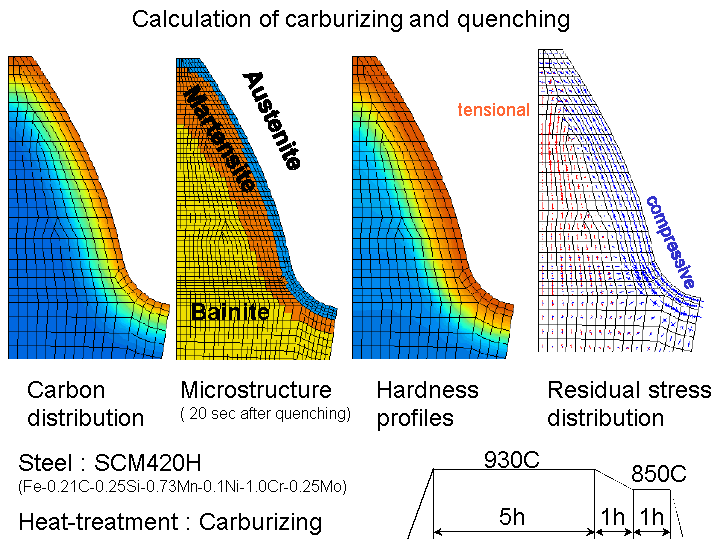
Figure 1
Many steel components such as shafts, gears and bearings are surface-hardened. It is useful to have a hard surface to resist wear, whilst at the same time having a soft core which is tough and hence can resist the propagation of cracks. A hard surface also reduces the risk of fatigue cracks initiating at the free surface due to cyclic stresses.
The chemical composition of the surface can be altered by the diffusion of carbon and/or nitrogen during carburizing or carbo-nitriding heat treatments. Carburizing is a process in which the carbon concentration of the surface is increased by inward diffusion at a temperature where the steel is in the austenite phase field (about 900oC); the diffusion flux is driven by conducting the heat treatement in an environment in which the chemical potential of carbon is larger than that in the steel. This environment may be gaseous (carbon monoxide or methane) or a solid mixture of charcoal and barium carbonate. The surface carbon concentration is allowed to increase to about the eutectoid composition and the component is then quenched to transform the surface into hard martensite. This may be followed by other heat treatments which optimise the overall properties of the component.
Nitriding can be carried out at lower temperatures (about 500oC) by treating the component in an atmosphere which contains ammonia (NH4). Because of the lower temperature, the heat treatment time has to be longer; this may add to expense. Carbo-nitriding is a combination of carburisation and nitriding.
Komatsu manufactures a great deal of heavy equipment. One example is illustrated in Figure 1, which shows a huge truck used in the mining industry. The truck has a payload capacity of 290 tons with a flywheel of 12500 horsepower (865 kW). The size of the truck can be gauged from that of the man standing next to one of its tyres.

Figure 1
Equipment like this relies on a great deal of gearing. The gears experience large loads in harsh circumstances. They have to be reliable (for example, resistant to fatigue) and must last for a long time. The properties of gears are improved by carbo-nitriding the surface regions. This is done by heat treating the gear in a gaseous atmosphere containing various combinations of CH3OH, C3H8 and NH3. This introduces carbon and nitrogen into the gear surface; the nitrogen reacts with aluminium in the steel to form nitrides (AlN). This hardens the surface and makes it more resistant to wear and fatigue.
|
Figure 2: The optical microstructure of a carbo-nitrided surface is shown here. The darker etching region contains the carbides and nitrides responsible for the hardening. The thickness of this layer varies with the square root of time, as predicted using diffusion theory. |
|
The calculations illustrated below show the effect of a carburizing heat treatment on the properties of a gear tooth. One of the most important consequences is the introduction of compressive stresses on the surface; this leads to an improvement in the fatigue life. Notice also that the hardness of the surface is increased, which helps the gear resist wear.

All the pictures and diagrams presented here have kindly been provided by Chikaro Nakao of Komatsu. His full presentation is also available.
| PT Group Home | Materials Algorithms |

|

|